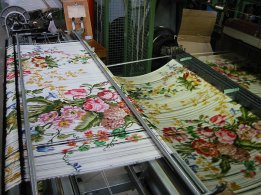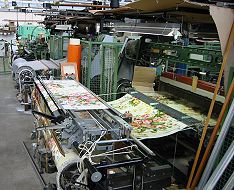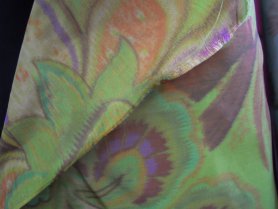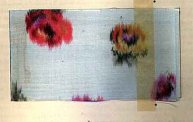- Home
- Resurrection ▾
-
Learn ▾
- Free library
- Glossary
- Documents
- Initiation
-
Shaped fabrics
- Introduction
- Popularization
- Definitions
- Le métier de façonné
- Principes du façonné
- Mécaniques de façonné
- Le jeu des crochets
- Les cartons
- Chaîne des cartons
- Mécanique 104 en détail
- Pour en finir
- Montage façonné
- Empoutage 1/3
- Empoutage 2/3
- Empoutage 3/3
- Punching, hanging and dip
- Autres façonnés
- Façonnés et Islam
-
Cours de tissage 1912
- Bâti d'un métier
- Le rouleau arrière
- Les bascules
- Formation du pas
- Position de organes
- Mécanique 104 Jacquard
- Fonctionnement 104
- Lisage des cartons
- Le battant du métier
- Le régulateur
- Réduction et régulateur
- Mise au métier d'une chaîne
- Mise en route du métier
- Navettes à soie
- Battage
- Ourdissage mécanique
- Préparation chaînes et trames
- Equipment ▾
- Chronicles ▾
- Fabrics ▾
- Techniques ▾
- Culture ▾
- Language ▾
Weaving silk printing on chain at Ets Mantellier in Bussières (Loire - France)



The digitization of this sample is poor, but the significant blurring of the pattern contours is fairly well rendered. The design seems blurred, and at the same time sheared as if the dye had drooled ...
Printing on the warp
It is a very original technique because it is integrated in the middle of the weaving process, unlike other fabric printing techniques such as roller printing or plate printing which are separate techniques Intervene downstream, that is to say after the weaving and no longer concern at all the latter ...

1- Preparatory weaving for printing.
It may be imagined that it would be rather difficult to make the impression on a warp, the threads of which would have no connection between them, the absolute parallelism between the threads which is necessary for the operation would be impossible to obtain. This is why it is necessary to carry out a first weaving of the chain, the purpose of which is precisely to bind the wires slightly to prevent them from moving on the printing table and to keep them absolutely parallel.This weaving must be done according to the taffeta armor, on a number of heddles (frames) of any kind but on a comb of the same reduction as that on which the final weaving will take place so that the drawing retains its proportions.The reduction in weft should be very low, 4 to 6 strokes to the centimeter, halved 1 raw organsin end, one should place on each side a strong cordeline to retain the weft and which will also serve to fix the fabric on the printing table And will later facilitate the disintegration.During this preparatory weaving, it is necessary to carry out a very thorough remodeling (verification of the condition of the warp threads) of the warp, because at final weaving it is no longer possible, for example, to replace a segment of damaged thread, Without producing a cut in the drawing.In addition to the precautions which we have just indicated, there are others, equally important, to be foreseen in regard to the handing over of the chain of printing to final weaving.
- At the beginning of the warp we must weave a strong drawer, that is to say 3 cm of taffeta with a reduction a little tight, 40 blows to the cm approximately, to make an inter-bat, in other words to leave a space of 3 cm and Weave again 3 cm taffeta; This drawer will facilitate the positioning of the chain on the printing table and, above all, will make it easier to stamp or hook the printed chain to the roll at the time of folding.
- At a distance of about 60 cm from the drawer make a wrapping by wires which will be held by means of two cords, which will be replaced later by the twisting rods to carry out the remounting and twisting.
- At the same distance of about 60 cm we weave a second drawer less tight than the first, it is from this second drawer that we start printing.
- Weaving the entire length of the chain as said above.
At the end one must make the same darts and send in reverse direction:
- A loose tie that indicates the end of the printing. - An envelope at a distance of 60 cm. - A second baffle 60 cm from the tighter slip for the blistering.
The chain thus prepared is sent for printing.
2- Definitive weaving.
The printed string is wound on the roll or beam by the hand-bending process and carried on the easel of the loom, twisting or resetting is carried out using the length and the spacing that have been reserved and Formed at the time of the preparatory weaving, then the final weaving is begun.
For this weaving to take place in good conditions and especially to avoid as much as possible the deformation of the drawing, the following precautions must be observed:
- Arrange the chain roller in such a way that it is only 1 meter long between the healds and the roller. - Only detangle in small lengths of 50 cm as the product is manufactured. - Minimize the shed necessary for the passage of the shuttle. - If the fabric is taffeta, the rails should be raised and lowered, this precaution should even apply whatever the armor.
All these precautions are indispensable if the impression is to be removed, but without being able to claim an absolute sharpness of the drawing. Moreover, the distinctive character of printing on a chain is precisely this blur, this fading of colors and shapes.